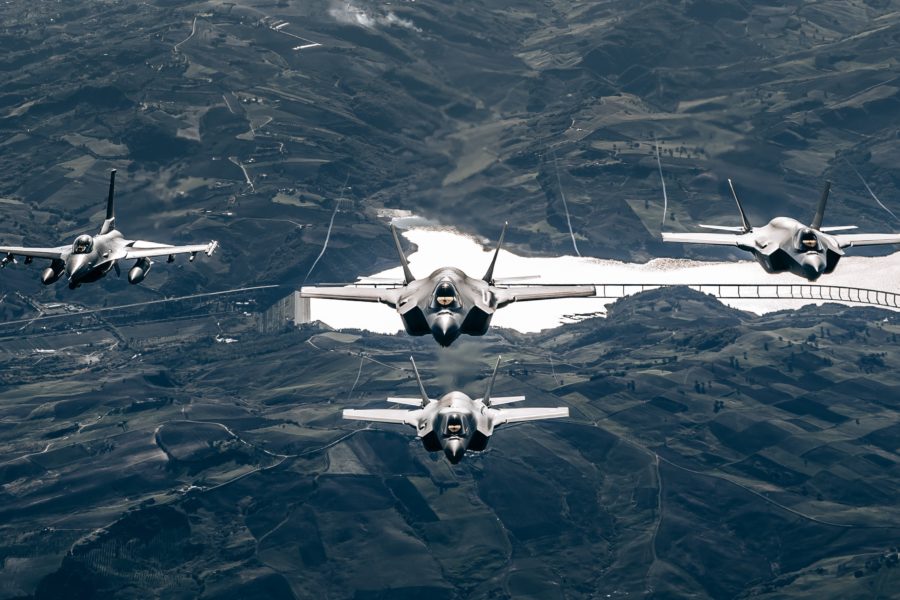The U.S. and allied air forces engaged in a two-week exercise with F-35s over the skies of Italy and the Mediterranean Sea as part of a push by the U.S. Air Force to work better with allies and to operate from more bases in the region. An accompanying meeting of F-35 air chiefs included 11 countries.
The exercise Falcon Strike 2022 wrapped up Nov. 25 and involved a mix of American, Italian, and Dutch stealth F-35 fifth-generation fighters flying alongside American fourth-generation F-16 Fighting Falcons. Italian command and control aircraft, tankers, and other assets supported the sorties. In total, the nations contributed more than 50 aircraft to Falcon Strike, according to the Italian Air Force.
“Falcon Strike prepares our F-35 pilots to carry out missions against current and future threats worldwide,” Maj. Mirko van Meerlant of the Royal Netherlands Air Force said in a news release.
U.S. Air Forces in Europe (USAFE) supported the exercise with F-35As from the 48th Fighter Wing based at RAF Lakenheath in the United Kingdom and F-16s from the 31st Fighter Wing at Aviano Air Base in Italy. USAFE said the exercise focused on integrating advanced F-35s—and the ever-expanding number of countries that fly the jet—with existing capabilities in the region such as the F-16. A spokesperson for USAFE said Falcon Strike 2022 is one of the largest exercises the command’s F-35s have taken part in since arriving in Europe in December 2021.
Amendola Air Base, the main air base that hosted the event, also held a meeting of top leaders of many air forces that operate the F-35 to “crosstalk” ways to employ the fighter and to give updates on how each nation is using its aircraft, according to USAFE.
For the U.S., the exercise advanced a broader goal for the Air Force. Agile combat employment, or ACE, was top of mind for the Americans at Amendola. ACE aims to move toward distributed operations and the ability to operate with a smaller footprint. The Air Force sees ACE as the way ahead as large American air bases may be at risk from missile attacks or other strikes from China or Russia, which present the main security challenges according to the National Defense Strategy.
“Our partnerships in the European theater provide the backbone of USAFE’s Agile Combat Employment doctrine,” a spokesperson for USAFE said of the exercise.
Gen. James B. Hecker, the USAFE commander, said Falcon Strike and the accompanying air chiefs meeting would help the U.S. draw on allied resources in the future.
“There might be times when a U.S. F-35 has to divert to another air base, or maybe we can even plan on going to another air base and we don’t have the maintenance or the equipment to go with them,” Hecker told reporters at the air chiefs meeting in Italy, according to USAFE.
Hecker said such flexibility is a necessity, not a luxury.
“I think it’s really a war fighting imperative to be able to do that,” Hecker said of ACE.
The meeting of F-35 air chiefs included top air force leaders from the U.S., Italy, Belgium, Canada, Denmark, Finland, Israel, the Netherlands, Norway, Poland, and the U.K. The Lockheed Martin-made F-35 has strong demand in Europe. Germany recently committed to buying 35 F-35s in light of Russian aggression.
“We looked at various options, and the F-35 is already being flown in Europe, and thus Europe has grown together,” German Parliamentary State Secretary Siemtje Möller for the Ministry of Defense told Air & Space Forces Magazine. “The F-35 was a big opportunity. We needed something we could buy now. We wanted to join the family of user nations. It will provide interoperability and shared capability throughout Europe and NATO.”
By 2034, more than 600 F-35s will be operating in Europe, according to Hecker, who also leads NATO Allied Air Command. In its statement on Falcon Strike, the Dutch Ministry of Defense said the event was “above all” focused on the F-35. Around 1,000 service members from the Netherlands, Italy, and the U.S. participated in the exercise, operating from multiple air bases on the Italian mainland and a training range in Sardinia.
Hecker hopes eventual deployments of U.S. F-35s to foreign bases can advance the goal of ACE. He said the U.S. and its allies aim to make the F-35 employable across Europe, irrespective of which air bases or air forces are involved.
“We’re trying to make it interoperable, so if any F-35 nation can work with any F-35, no matter what nation it comes from, it can work on it—not just refuel it, but rearm it as well,” Hecker said. “We want to get to that stage in the game, and this is the beginning of that.”
